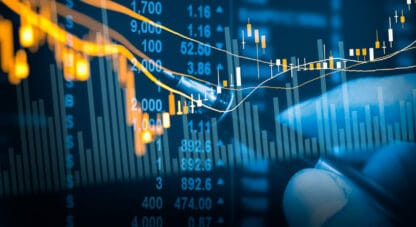Podcast: Play in new window
- Will The Most Owned Stock In History Become The Most Sold Stock In History?
- Platinum Deficit Is Coming. Do You Own Some?
- Call For Your Bank Rating – 800.525.9556
Apple Larger Than Everything Else In Russell 2000
May 17, 2023
“We still have incredibly low unemployment numbers, but the initial jobless claims—these numbers are starting to pick up. When claims begin to rise off of a cycle low, how much they rise and how fast they rise tell you something important. Twenty percent increase off cycle lows suggest a recession is imminent. By the time you get to 25% above those cycle lows, the recession is essentially starting. With the claims data from last week, we’re now at 50%, above the September 2022 cycle lows.” — David McAlvany
Kevin: Welcome to the McAlvany Weekly Commentary. I’m Kevin Orrick, along with David McAlvany.
Dave, I really appreciate that you put me on to so many good books, but reading with you right now David Mamet’s book, he’s the famous theater guy and he causes a lot of controversy because he was a liberal until he was in his sixties, and then he read Hayek’s book.
David: The Road to Serfdom.
Kevin: And it changed a lot of his beliefs, but actually the truth of the matter is, he found out that his beliefs weren’t changed, his life experience had confirmed it. He had just had a bias over onto the left side.
David: Yeah, there are many things that we neglect to see, and there’s many more that remain unseen through some sort of willful neglect. Bias is something that everyone has, but not everybody has accounted for as they’re looking at the world and come to judgments of the way the world works and what actions make the most sense.
Kevin: Well, and sometimes we are looking for an echo chamber. Oftentimes we’re like, oh, I love what this person said, but really what’s the truth is that they’re actually just reinforcing our prejudices. I’ll quote David Mamet here. He said, “Bad drama reinforces our prejudices. It informs us of what we already knew before we came into the theater.” He says, “My task is this. We’re not here to affirm your prejudice, but to engage you in a dialogue about them,” ideas about them. That’s the thing. I don’t want to see the Weekly Commentary ever become an echo chamber for everybody who’s listening. I mean, it needs to stimulate their thinking.
David: Bias can be of the social variety, where you maintain an irrational judgment of people, based on some categorization, age, gender, weight, country of origin. And the conclusions you come to can remain unfounded on an evidential basis or on a logical basis. There’s another kind of bias, and it’s the cognitive bias, and that can be equally disconnected from reality. And it’s cognitive bias that I think of when in past weeks we’ve discussed the leadership of a few names in the equity market with no broad based participation of other stocks. Many analysts prefer to avert their eyes rather than explore what it means. We’ve referenced the Russell 2000 and the value line index also illustrating the same point—that breadth of participation in this first quarter–second quarter 2023 rally is lacking. Prices rising on unimpressive volume, only in a few names, is how you would define an anemic market.
Kevin: Yeah. You’ll hear when the market’s rising in one stock in particular, it could be Amazon, it could be Apple, whatever it is. It’s like, gosh, I need to put money into that. And you know, talk about cognitive bias, though. I have it. When I’m not spending my money, what do I do? I put it into the banking system, Dave. It’s just habit. It’s what we all do. In fact, we get automatically paid right into the banking system as we now are watching this thing failing bank by bank by bank.
David: Weiss ratings is a service that we’ve subscribed to for probably 25 or 30 years, and we’ve provided free ratings to any of our clients. Frankly, you can call us. You don’t have to be a client. We’ll be happy to provide a free bank safety rating. But it’s interesting to me that, in a recent interview, the folks at Weiss said, “we’ve changed the number of banks that are on our imminent failure list.” And they’ve got about a 99% accuracy rate on this imminent failure list.
Kevin: Going back to 2008, I think is what they were measuring.
David: Yeah. Now there’s 1,243 banks on their imminent failure list.
Kevin: 1,243 on imminent failure.
David: Yeah. I think it’s worth getting a safety rating, and just being aware of the fact that autopilot in this period of time is probably not the best way to approach the landscape that’s coming up in front of us.
Kevin: Yeah. So give us a call at (800) 525-9556 and we’ll give you a bank rating. We’ve done that— actually, Dave, it’s longer than 25 or 30 years. I’ve been here 37 years, and I’ve been giving bank ratings since I was 24 years old. I’m 60 now.
David: So it has been a little bit longer. On the way to the office today, I was listening to National Public Radio, and the interview was very interesting. They had two young immigrant ladies from different parts of the world, said, it’s very difficult to get a credit card in the United States as an immigrant. You have no credit history, and so credit cards are not really freely on offer. But more than that, it’s a strange thing to come from a different culture where credit is taboo and it’s not something that’s celebrated. Nobody celebrates their credit score because it’s a bad idea to be in debt in the first place.
Kevin: Yeah.
David: It was a really—
Kevin: It’s almost backwards thinking, isn’t it?
David: —fascinating exchange. One gal from India, she said, “The amount of credit that you have in the United States versus in my country is 40 times.” If you’re looking at household credit relative to GDP, it’s 40 times that of India—and it’s two times that of Europe, if you wanted to stay in a more developed part of the world. We have an enormous amount of debt. We’ve assumed that this is normal. We look at the way banks are— What do banks do? Banks generate new IOUs. That’s the nature of their business, is to take your savings and turn it into an IOU. And so it really was just a healthy check to say, what is this that’s going on?
Kevin: What do we celebrate? We celebrate debt.
David: We do.
Kevin: That’s an amazing thing.
David: That’s right. And in our system, we’ve talked about this many times, even going back to the conversations with Richard Duncan, where capitalism, in its purest form, a market oriented ideal has been replaced by creditism, where growth is tied to an increase in the quantity of IOUs. And that’s what we celebrate, this faux form of wealth.
Kevin: It’s the opposite of ownership, yet that’s how we treat it. But I wonder if it’s not human nature too, because here in America, what do we celebrate in stocks? I mean, we like to go buy the most expensive stocks ever and call it good, and think that we’re in the right place.
David: Well, again, if we’re talking about household credit, the bigger the better. How do you afford the house that is 3,000, 4,000, 5,000, 15,000 square feet?
Kevin: A good credit score.
David: The bigger, the better.
Kevin: There you go.
David: And so it’s not, if you have the money to purchase the asset, it’s if you have access to the credit, to borrow from the bank, and can make payments on that debt, it’s all cash flow related.
Kevin: Guess how much I can borrow? Guess how much I can borrow?
David: But the bigger, the better. And as I think about stocks today, that’s true as well. We’ve talked about cap-weighted versus market-weighted indices in the last few weeks. Apple’s market cap, just one company, now exceeds all the companies in the Russell 2000.
Kevin: Wow. Wow.
David: So separately, if you wanted to compare it to an exchange, Apple’s market capitalization exceeds the value of all the companies in the Toronto Stock Exchange, and this just changed recently, but Apple’s valuation did exceed— It exceeded the total capitalization of the London Stock Exchange.
Kevin: So all the stocks on London, all the stocks on Toronto.
David: Until the move higher in the pound sterling, and now it’s slightly below. But Apple today is just an iteration of what we’ve seen in the past. Apple today is what IBM was, in its day. Apple today is what ExxonMobil was, in its day. What General Electric was, what AT&T was, for earlier generations. The priciest stock, by market cap, ever recorded, and that phrase applies to each of those companies. IBM, ExxonMobil, General Electric, AT&T. The priciest stock, by market cap, ever recorded. Now you know what the perennial problem is? Maintaining the limelight. None of those companies are the most expensive stock anymore.
Kevin: Well, and speaking of maintaining the limelight, a lot of times Wall Street is a little bit like a circus, or it’s like, actually, it’s like the news. Just because you see something as breaking news does not mean that it’s newsworthy. What it means is, it’s something that will get people’s attention. So Wall Street has their own cognitive bias, do they not?
David: Well, sure. And again, we come back to unimpressive volumes and we talk about breadth and the participation in these moves higher and how it’s only a few names that have been driving the indexes higher. Wall Street’s cognitive bias is, more often than not, to ignore divergent relationships and generously interpret the good and the bad as equally good—the typical basis for hawking Wall Street wares. And what does Wall Street sell, exactly? They sell stocks, they sell bonds, they sell some derivative of these two, and it requires that the audience for these products see the future prospects as bright. Bright enough for those very investors to part with capital today so that something bigger and better will be delivered tomorrow.
Kevin: Well, and lest we forget, we’re sitting here, too, people of cognitive bias ourselves. I mean, we have a mirror. We could probably say, well, gosh, you could be accused of maybe being a little too doubtful of the market right now.
David: Sure. Merely the other side of the coin. And I guess a part of this is because we do focus on risk management as a pillar of what we do and how we do it. So could our bias merely be the other side of that coin? Where again, we look at this as a justification, a negative bias in matters of market direction. And I think that’s fair. When we think of growth, it is through a complete cycle, which captures the upside, the gains, and, to the greatest degree possible, avoiding losses on the downside too. So the risk mitigation aspects don’t feel overly negative, but perhaps they are. And I don’t think whether you are overly positive or overly negative, optimist or pessimist, neither is inherently wrong, but to ignore what may be a chosen form of blindness, a willful ignorance—that can have serious consequences. And that’s why I’m lingering on that idea of cognitive bias.
Kevin: And I think that’s also why we both really appreciate our wives, because our wives, if we’re blind to something, at least in my case, and I think with yours too, because they’ll check and say, “Hey, you’re blind to something right now.” And it’s good to have that humility where you’re checking. You want to know what you’re missing.
David: Right. My wife and your wife, just to be clear, singular instead of plural.
Kevin: Oh, yeah, yeah. I guess we both are on singulars, which I’m very, very—
David: No, there’s enough complexity in that universe. To multiply that out would shatter my mind.
Kevin: I’m about to hit 40 years of marriage this week.
David: That’s fantastic.
Kevin: Isn’t that amazing?
David: Gosh, that’s amazing.
Kevin: Yeah. Wonderful.
David: Well, the art and science of being a market practitioner includes not only knowing a thing or two about the market, about its historical behaviors under different circumstances, but to know a thing or two about yourself as well. In the Greek, it’s gnothi seauton, and I’m probably not pronouncing that right. It’s been a lot of years since I took Greek. And I was reminded by a friend this morning, the Latin, nosce te ipsum, they’ve long been a prerequisite for success in life and in relationships. They both mean know thyself. “Know thyself” is the rough translation of each. This includes what we like and don’t like. It’s our strengths and our weaknesses. And again, to be a market practitioner, you have to know where you are and who you are.
Kevin: Well, and I never took Greek and I never took Latin. I sometimes use English, and know thyself, that’s very, very important. But going back to bias, we do have to put the mirror up and say, all people have particular bias.
David: And no one wants to be painted as biased. Or to be prejudiced, either in the first sense, again, going back to social bias, or in the second sense, cognitive bias. Yet there is no person alive today that is unprejudiced. The term has been narrowly focused on issues of race and gender, just to name a few, and thus it’s become a hot button in debates and even a simple catchall as an ad hominem. Again, oh, you’re just a this or that. So we can destroy someone’s character by revealing a prejudice.
But prejudgment, the basis of that word prejudice, is merely what we bring into a situation as a baseline assumption. It could be correct or it could be false; it could be flawed. And quite often it’s not examined. It’s just assumed. Again, you might be wondering where this is going. The Wall Street assumption is still largely that rates are near their worst. In other words, they’re high enough to bring down inflation. Nobody wants higher rates because it brings pain into the system. And so when I say “at their worst,” they’ve gotten to a high enough level to be just painful enough to have done the job. And if that’s the case, then the gradual tightening of financial conditions is nearly over.
Kevin: So they’re bullish. Their bias is bullish.
David: We’re bullish on growth, and that’s what we all should be is bullish on growth. Equity investors have convinced themselves that, in fact, what we see in the yield curve, this yield curve inversion, it suggests that looking ahead we see brighter days, lower rates. That must mean an “all clear” signal for inflation. The monster’s destroyed, and its inflicted wounds are already in the healing process.
Kevin: But don’t inverted yields almost always say recession?
David: Well, and again, this comes back to bias. It comes back to what lens do you see the world through? And the bond investor sees things very differently. The bond investor sees the inverted yield curve still suggesting recession ahead. Not happy days on the horizon, but a significant contraction. Lower rates as an expression of desperate Fed policy accommodation, a reaction to asset price disinflation. Consumer price inflation, in fact, being displaced as market dislocation becomes the focus of monetary policy, even more important than inflation.
Kevin: So you have the bond bias, you have the stock bias, and you have to, as a wealth manager, try to figure out which one works.
David: Both perspectives are biased. Acounting for the facts, interpreting the facts, and appreciating the lens through which you see the facts, is the challenge every day.
Kevin: But you were talking about credit, and let’s go back to credit because we count credit as wealth. The people who actually distribute the credit—let’s go back to the banks. The bankers are tightening up their lending standards. You brought that up over the last couple of weeks.
David: Well, and I think that’s a fair comment. It’s not really the increase or decrease of credit, which is wealth, and yet that’s how we do account for economic activity, viability, even a form of wealth. And so there’s an issue, highlighted by both Mike Wilson of Morgan Stanley and David Kostin of Goldman Sachs, I think worth considering, and it overlapped some of our comments from last week. We spoke of the SLOOS report last week—again, the Senior Loan Officer Opinion Survey on bank lending. What this is about is, the folks who are running banks, they’re saying, we’re going to have to tighten the conditions that have to be met in order to offer this credit into the system. These loans will not be made unless you reach a new and higher bar.
And so, as an important indicator of bank lending officers’ biases, this gives us an idea of how far they’re going to raise the bar for loans and thereby limit credit accessibility across categories. We did mention last week the one exception to that would be the off-loadable government sponsored entities, their qualified paper, that being the one exception. These gentlemen point out that when bank lending contracts, particularly with commercial and industrial loans, earnings per share—thinking of the stock market here—earnings per share come under pressure with a lag of two months, suggesting that we are already well towards the arrival of a slowdown in earnings and what at a certain threshold would then be considered a recession.
Kevin: So is there anything new to add to what you were talking about last week? I mean, any new information that would say that there’s not going to be a recession?
David: Nothing new to add to our previous comments on the likelihood of a recession hitting somewhere between June and September. We think that’s the timeframe that we see this.
Kevin: That’s pretty soon.
David: We’ve said that before and we say it again, tightening financial conditions and bank lending fits the bill nicely, and are part of a slowing economic activity. We’d see that in the economy. What Mike Wilson and David Kostin of Goldman Sachs and Morgan Stanley are saying is, you’ll see it impact corporate America and you’ll see it on a two-month lag from tight lending to a decline in earnings per share measures. There is a direct impact. And of course, if you’re going to see a decline in EPS, you’re going to see a decline in share price most likely as well. So to have two of Wall Street’s chief equity strategists read the SLOOS report and conclude, as we have, that the second half of 2023 may hold significant challenges for growth and many surprises on the downside, what that suggests is that the Wall Street bias is shifting. As the bias shifts, so do the allocations across portfolios.
Kevin: And you watch allocations. You actually watch what people are thinking about the market using credit default swaps, CDSs, and you bring this up often in the Commentary. What’s happening on the CDS market right now as far as allocating of bond funds?
David: Well, speaking of allocation shifts, yeah, we do watch CDS pricing, and we also watch spreads very closely. And the US high-yield spread to Treasurys is at a very modest level—the difference between a Treasury yield and a junk bond yield—those spreads have not widened considerably. And when you see them widen, it’s an indication of stress within the fixed income markets. A Financial Times article from May 13th discussed the eminent selloff in junk bonds, and they showed a chart from Haver Analytics overlaying the SLOOS percentage response to tightening lending to small firms with the movement in high-yield spreads. Very fascinating chart. If you have a subscription, again, go back to the May 13th edition and look for that.
Kevin: What would cause that selloff? I mean, in junk bonds, are people just moving to higher quality paper?
David: Well, the coincidence of both of these indicators moving in the same direction has been uncanny. For 20 years the movements of the SLOOS percentage have accurately predicted the movements to follow in junk bond yield spreads. And we’re now in that “any day now” timeframe for a blowout in spreads. Translate that roughly as a collapse in junk bond prices. Two sides of the seesaw: If junk bond prices are declining, the yield is increasing, and that differential between the Treasury and the junk bond yield is now widening, and that’s what we call the spread.
So just know that credit is the issue in the second half of this year. And if we’re right in thinking that junk spreads widen considerably over the next few months at the same time bank lending is hitting the small- and medium-sized firms, you will have a credit mash-up in the fall, which will worry even the steadiest hand at the Fed and certainly more of your chief equity strategists across the Wall Street landscape.
Now, a couple of statistics just on high-yield—what are more commonly known as junk—bonds. Before the euphemism high-yield was introduced, junk bonds is what everyone— You had the junk bond king Michael Milliken, he wasn’t the high-yield king. So we had eight billion in inflows. This is roughly speaking, leave the decimals off. So, simple math. Eight billion in inflows into junk bonds in April, and May has gotten kicked off with nearly 1.6 billion in outflows. These are liquidations of high yield junk bonds. So maybe this is the beginning of something. We’ll have to see.
Again, go back to the overlaid statistics from the SLOOS percentages and high yield spreads, and you would say, yes, that’s exactly where they’re going. Yields are going much higher. One thing is for sure: As goes corporate credit, so goes corporate equity. If bonds sell off, and we’re talking about investment grade and junk yields moving higher, we’re not only going to have an economic recession in the fall, but the next leg of the bear market on Wall Street.
Kevin: Well, and also talk about “as goes.” Let’s fill in the as goes. Our economy is a consumption-based economy. If the consumer starts to get nervous and starts to pull in and not spend nearly as much, consumption, when that drops, the sentiment indexes. That’s another factor that we have to look at.
David: Yeah. As goes the sentiment, so goes the spending, you could say. And of course that does hit the economy particularly hard. More so in our economy than in others where consumption is 70% of GDP. Last week, we had both the University of Michigan Consumer Sentiment Report and the Federal Reserve Bank of New York’s General Business Conditions Index, both of which were surprisingly weak. So, on the Fed’s numbers, the Fed’s index broke through the zero line, which is an indication of contraction. Again, General Business Conditions Index. It tumbled 42.6 points to a negative 31.8. Again, the zero line indicates contraction. We’re negative almost 32 points. No one—no one—expected that.
Kevin: Yeah, so you’ve got that drop, plus you’ve got this rise in rates, or yields in junk bonds. All these things seem to be playing into each other.
David: Yeah. The consumer survey, back to U Mich. The University of Michigan was equally bad, but, again, from a different perspective—this is the consumer’s perspective as opposed to a survey of business managers. So the main sentiment measure for the University of Michigan, consumer sentiment number, fell 9%. The year-ahead expectations for the economy—so where we think we’re going to be a year from now—fell 23%. And the long-run expectations for the economy—this is sort of like in years and years ahead—fell 16%.
Kevin: Wow, that’s pretty pessimistic.
David: Long-run inflation expectations—also from the U Mich numbers—long run inflation expectations rose to their highest reading since 2011. And sticky inflation is, just to bear in mind, it’s more than a CPI figure, it’s more than a PPI reading. We had moderate numbers last week for both of those. Sticky inflation, it’s in the minds of people because, to be honest, that’s the reality that people experience. Once you have elevated pricing, it still aggravates the household budget. Inflation has increased. Now what we’re measuring is the continual pace of increases, and the pace of increases has slowed, but you’re already agitated by high prices and it’s only getting higher at a minorly less offensive level. It’s not like prices are falling. So when CPI and PPI come down, it’s only up less than it would’ve been otherwise—which is different than, on balance, prices dropping.
Kevin: Okay. So bringing up CPI and PPI, you brought up CPI for China. Was that going to be an issue? It’s come out since the last week’s program.
David: That’s right. And I think really a non-event, Chinese CPI last week. It’s still begs the question, where is $2 trillion in recently created credit going? To see no movement in Chinese CPI, and to not see the stock and bond markets of China go absolutely bonkers as trillions of dollars in credit is introduced in a very short period of time, it suggests that they may be sitting atop a black hole. I don’t know where it went. It might have just gotten sucked in.
So coming back to this side of the pond, the National Federation of Independent Businesses, the NFIB, Small Business Optimism index, like Chinese CPI, not a real big change—not a large decline. In this case it was minus 1.1 for April. But as my colleague noted in Hard Asset Insights this weekend, this is the 16th consecutive measure below the survey’s average, looking at almost a 50-year historical average. So it’s not healthy, not optimistic. And then you take all of these other measures and say, well, this is an interesting picture being put together.
Kevin: Last week I brought up that recession is when your neighbor loses his job. Depression is when you lose your job. But actually we have had very, very low unemployment up to this point, but there seems to be a change.
David: Well, and we still have incredibly low unemployment numbers, but the initial jobless claims, these numbers are starting to pick up. And again from Hard Asset Insights, when claims begin to rise off of a cycle low, how much they rise and how fast they rise tell you something important. A 20% increase off cycle lows suggest a recession is imminent. By the time you get to 25% above those cycle lows, the recession is essentially starting. With the claims data from last week, we’re now at 50% above the September 2022 cycle lows.
Kevin: Wow. So 20% suggests a recession, 25% is a recession, and now it’s 50% all of a sudden.
David: Right. Suggesting from one more vantage point that recession is an emergent phenomenon, and while it might take the National Bureau of Economic Research months to name it what it is, they will likely backdate this one to include that June to September as the recessionary ramp up. So the NBER, recycling previous commentary on this theme, we’ve got oil and copper, which are confirming that the global economy, not just the US domestic economy, is grinding forward at a slower and slower pace. So it’s declining demand which is the concern currently being priced in for both the oil markets and the copper markets, even as the supply picture for both of those commodities—again, supplies being fairly sparse—makes for a strengthening long-term case for the price action of both of those commodities.
Kevin: This is where commodities are interesting because you have to produce a commodity to sell it, basically. And so when prices go down, oftentimes production goes down. And this is why you have these huge cycles in commodities, because if prices go down, people stop producing it because it gets to be too expensive—
David: And that solves the problem.
Kevin: —and then it just goes away.
David: Right. So the cure for low prices is low prices. The cure for high prices is high prices.
Kevin: But especially in commodities.
David: And platinum’s at an interesting juncture. Global platinum demand is expected to be up in 2023 between 20 and 28%. So the consumption demand, that appears to be very positive. And then you’ve got a deficit in supply, which is forecast at 77% more than last year’s. The deficit in supply is being exacerbated by electricity blackouts and mine supply disruptions in South Africa. South Africa is responsible for 70% of global production of that particular commodity, with Russia being number two. Good luck getting many ounces out of Russia.
So believe it or not, the supply disruptions in this case are related to copper. You’ve got so many thieves stealing copper for recycling that trains, power lines, various parts in the energy infrastructure of the country—and this is needed for households and industry as a whole—they’re routinely inoperable. So this may end up being the biggest deficit in ounces since the 1970s. And this is according to the World Platinum Investment Council. We’ve been oversupplied for two years, given semiconductor shortages in the auto sector. And you currently have a stockpile of metal, 90% of which resides in China.
Kevin: Oh, that’s interesting.
David: Very interesting. But maybe those stockpiles become available at a price, and so we’ve got this overhang of a couple million dollars.
Kevin: Or maybe not. Do you remember when the Russians wouldn’t sell their palladium? They just sat on the palladium.
David: And maybe stockpiles like that are immovable at any price, representing a diversification away from dollars and dollar assets.
Kevin: I wonder if that’s similar to the central bank buying of gold. You talked about how traders and speculators are going to buy and sell gold, but a central bank, when they buy it, they just hold on.
David: That’s right. So when you’re thinking about a world of contrasts, we have the US selling our strategic petroleum reserves to try to do a solid for the average middle class guy and gal out there. So we brought them down to like 40-, 50-year lows, and just now are considering adding back. Meanwhile, other countries in the world look at mineral reserves and oil reserves, and they’ve bought as much as they can to store away as much as they can.
So maybe platinum fits that. It’s not exactly like gold—gold purchases by central banks. Those are official central bank purchases. And I look at the current gold market, it’s really interesting. Futures traders are fickle and opportunistic. Reserve managers are pragmatic and political in their choices. We’ve highlighted the record amounts of central bank gold buying in recent weeks. We have not adequately highlighted the percentage of total central bank reserves these purchases now represent. So consider for a moment that between 1960 and 1990, so go back a few decades, the average percentage gold holding—the total currency reserve—varied from 40 to 80%. It was bouncing up and down, but it was bouncing in a range between 40 and 80. I’m not talking about an average for all countries, I’m talking about where it was moving in that 30-year period.
Kevin: That was the golden age of central bank reserve holding of gold.
David: As low as 40%, as high as 80%. That declined to less than 15% in the age of reckless financialization through the ’90s and 2000s. So in recent weeks, as we’ve talked about, record tonnage being bought by central banks—all of last year, Q4, first quarter of this year being very strong. That brings us to current allocations of 20%.
Kevin: But think of how much money’s been printed since then. I mean, 20% of all the new money that’s been printed.
David: Well, that’s right. So it tells you something about the currency reserves globally. To have increased the tonnage so substantially and remain at current percentages of total reserves—again, at the low end of the spectrum—we are awash in paper assets. And I think it’s fair to say there’s still room for those allocations to migrate north and drag the price of the metal with it. Just wait for investor enthusiasm to match even the muted enthusiasm of the central bank community. We see a current correction in the metals. We talked about the US dollar being at a critical point, 101 to 103, still in that trading range, but now at the upper end, near 103. It’s a very critical level. When we talk about critical price levels, this is not just a point of curiosity.
Kevin: This is a critical breaking point.
David: When 101 breaks, and that’s not if, but when 101 breaks, you’re talking about a redefining moment in the gold market. The fact that we’ve bounced off of the 101 area, not a surprise at all. So where do we go in this correction for gold? Do we see 1900? Do we see 1850? Do we see 1800? It’s anyone’s guess. I think at this point, it’s largely predicated on how strong this bounce is in the dollar off of the 101 area. But thinking about the investor and investor enthusiasm for gold, just as we’ve seen the central bank community make its move, when will we see investor enthusiasm? I think it’s when Apple rediscovers gravity.
Kevin: Yeah. When it’s no longer the apple of their eye, gold becomes important.
David: It’s fascinating to me that we’ve set aside how cyclical revenues are for Apple. It takes between two and four years—if we’re looking at the last 12-month revenue for Apple—it takes between two and four years to find a bottom after putting in a peak, and Apple’s numbers peaked in the fourth quarter of 2021. Since then, the shares have diverged and moved higher. And the question remains, will the most over-owned stock in history, become the most sold stock in history? And in those days, I think investors will discover a preference for gold as central bankers already do now.
Kevin: You’ve been listening to the McAlvany Weekly Commentary. I’m Kevin Orrick, along with David McAlvany. You can find us at mcalvany.com, M-C-A-L-V-A-N-Y.com, and you can call us at (800) 525-9556.
This has been the McAlvany Weekly Commentary. The views expressed should not be considered to be a solicitation or a recommendation for your investment portfolio. You should consult a professional financial advisor to assess your suitability for risk and investment. Join us again next week for a new edition of the McAlvany Weekly Commentary.
















